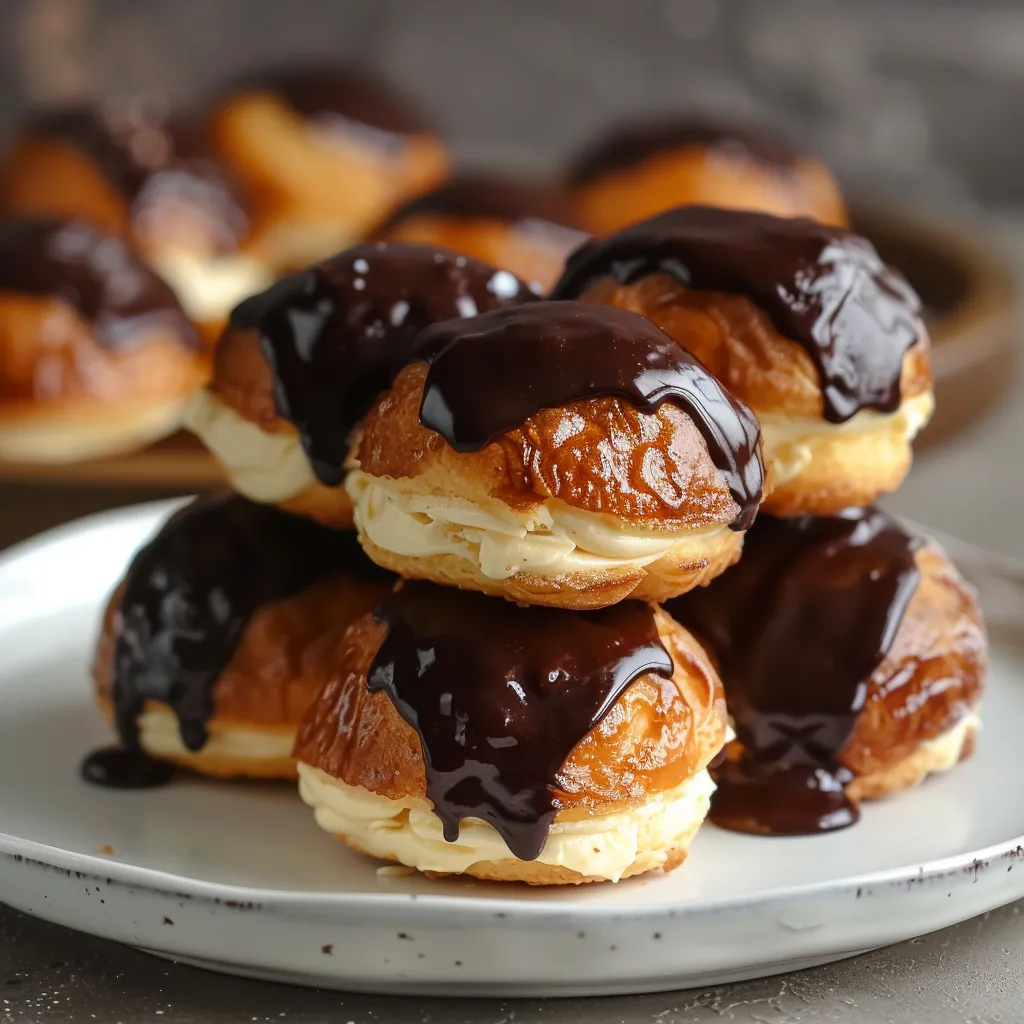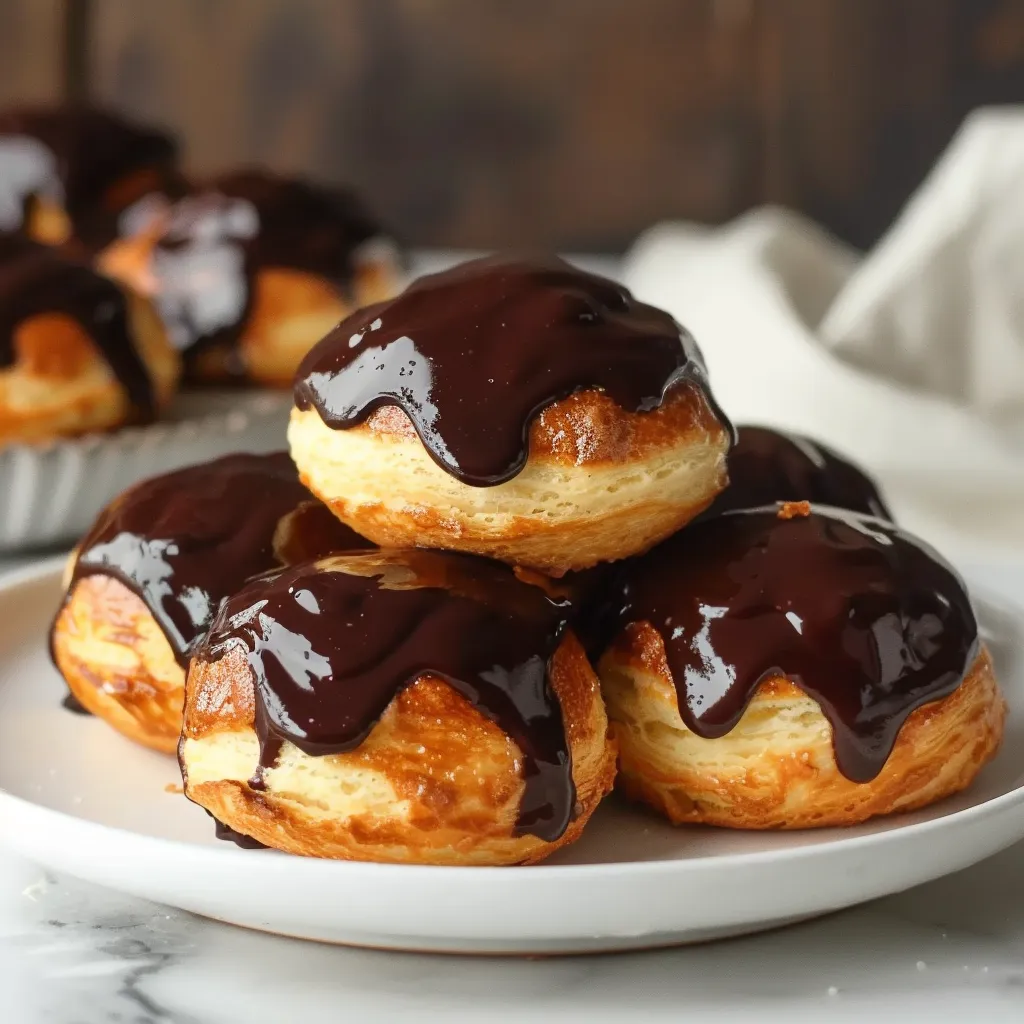 Pin it
Pin it
The intricate art of creating perfect profiteroles represents the pinnacle of French pastry craftsmanship, demanding precision, patience, and understanding of complex techniques. These ethereal choux pastry puffs, when executed properly, should rise dramatically in the oven to create a golden brown exterior that gives way to a delicate, hollow interior perfect for filling. The combination of light-as-air pastry shells, silky smooth vanilla-scented pastry cream, and glossy chocolate sauce creates a dessert that engages all senses, from the subtle crackle of the shell to the rich aroma of premium chocolate.
My journey with profiteroles spans decades, beginning in my grandmother's sunlit kitchen where I learned that the sound of the choux pastry mixing against the sides of a hot pan would tell you when it was ready. Years of practice have taught me that the temperature of each ingredient and the humidity in the air can affect the final result.
Essential Ingredient Selection
- Bread flour: Select high protein flour with at least 12% protein content that provides the strong gluten network needed for proper shell structure
- Farm fresh eggs: Choose large eggs weighing exactly 55g each, brought to precise room temperature of 68°F for optimal incorporation
- Premium European style butter: Opt for butter with minimum 82% fat content and rich yellow color for superior flavor and proper moisture content
- Pure vanilla beans: Source grade A vanilla beans with visible oils on the surface, split and scraped for maximum flavor impact
- Artisanal dark chocolate: Select chocolate with 70-75% cocoa solids for ideal sauce consistency and sophisticated flavor profile
- Heavy whipping cream: Use cream with 36-40% fat content for optimal sauce texture and pastry cream stability
- Fresh whole milk: Choose organic milk with 3.5% fat content for proper pastry cream structure
- Professional grade caster sugar: Fine sugar particles ensure complete dissolution in both pastry cream and choux pastry
Creating Perfect Components
- Initial Preparation:
- Begin by measuring all ingredients with precision using a digital scale for accuracy within 0.1 gram. Arrange your workspace methodically, with components grouped by usage order. Position oven racks in the middle position and preheat for at least 30 minutes to ensure stable temperature. Line baking sheets with high quality silicone mats or parchment paper secured at corners to prevent movement during piping.
- Pastry Cream Mastery:
- Heat the whole milk and vanilla beans in a heavy bottomed saucepan over medium heat until tiny bubbles form consistently around the edges, reaching exactly 180°F. Meanwhile, whisk egg yolks with sugar until they reach the ribbon stage, falling in thick streams that hold their shape for exactly 3 seconds. The incorporation of flour and cornstarch must be gradual, ensuring absolutely no lumps remain before introducing hot milk.
- Choux Pastry Excellence:
- The water, butter, and salt must come to a rolling boil, creating large bubbles that break the surface consistently. Add flour all at once, stirring vigorously with a wooden spoon until the mixture forms a smooth, glossy ball that leaves a thin film on the bottom of the pan - typically exactly 2 minutes and 45 seconds of continuous stirring. The paste should register 165°F before adding eggs.
- Egg Integration Technique:
- Allow the paste to cool to exactly 140°F before adding eggs. Each egg must be thoroughly beaten before incorporation, adding just enough to achieve the perfect consistency where the batter forms a "V" shape that slowly dissolves back into itself over exactly 3 seconds.
- Professional Piping Methods:
- Fill a 16-inch piping bag fitted with a 1/2 inch round tip no more than two-thirds full. Hold the bag at exactly 90 degrees to the baking sheet, applying consistent pressure to pipe 1.5-inch diameter mounds.
 Pin it
Pin it
My profound respect for these techniques deepened during my apprenticeship in Paris, where I learned that even the direction of incorporating eggs can affect the final texture of the choux pastry.
Elegant Serving Approaches
Transform these profiteroles into a stunning visual masterpiece by arranging them in traditional French croquembouche style, carefully building a conical tower secured with delicate threads of amber caramel. For plated presentations, arrange exactly three profiteroles in a triangular formation on hand-warmed plates, garnished with fresh mint leaves and a dusting of powdered sugar.
Creative Interpretations
Elevate these classic profiteroles through thoughtful variations that respect traditional techniques while introducing contemporary elements. Infuse the pastry cream with Madagascar vanilla beans, then layer in flavors like dark roasted espresso or ceremonial grade matcha.
Storage Science
Preserve the integrity of each component through precise storage methods. Unfilled choux puffs must be stored at exactly 68°F in airtight containers lined with moisture-absorbing parchment paper.
 Pin it
Pin it
The mastery of profiteroles represents a journey through the heart of French patisserie. Each batch teaches valuable lessons about the interaction between temperature, technique, and timing.
Frequently Asked Questions
- → Why do my profiteroles deflate after baking?
- Let them cool in the oven with the door slightly open for 10-15 minutes. This gradual cooling helps them maintain their shape.
- → Can I make these ahead of time?
- Yes, unfilled shells can be stored in an airtight container for 2 days, or filled profiteroles can be refrigerated for up to 3 days.
- → Why does the dough need to be cooked on the stove?
- Cooking the dough helps remove moisture and creates the proper structure needed for the pastries to puff up correctly.
- → Can I freeze profiteroles?
- Yes, unfilled choux puffs can be frozen for up to 3 months. Thaw and crisp in the oven before filling.
- → What's the best way to fill profiteroles?
- Make a small hole in the bottom of each puff and pipe the filling in until it feels heavy. This ensures even filling distribution.
